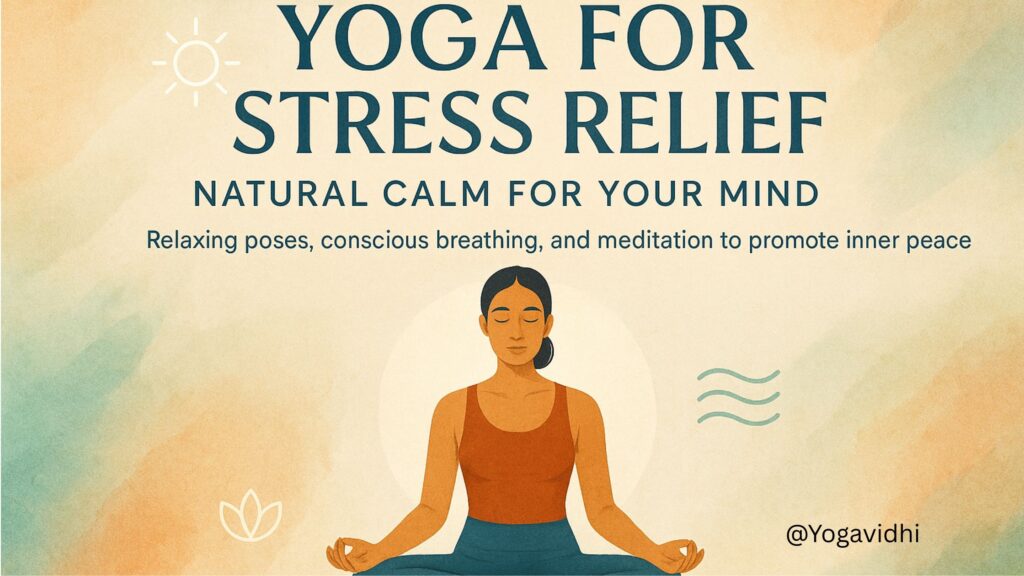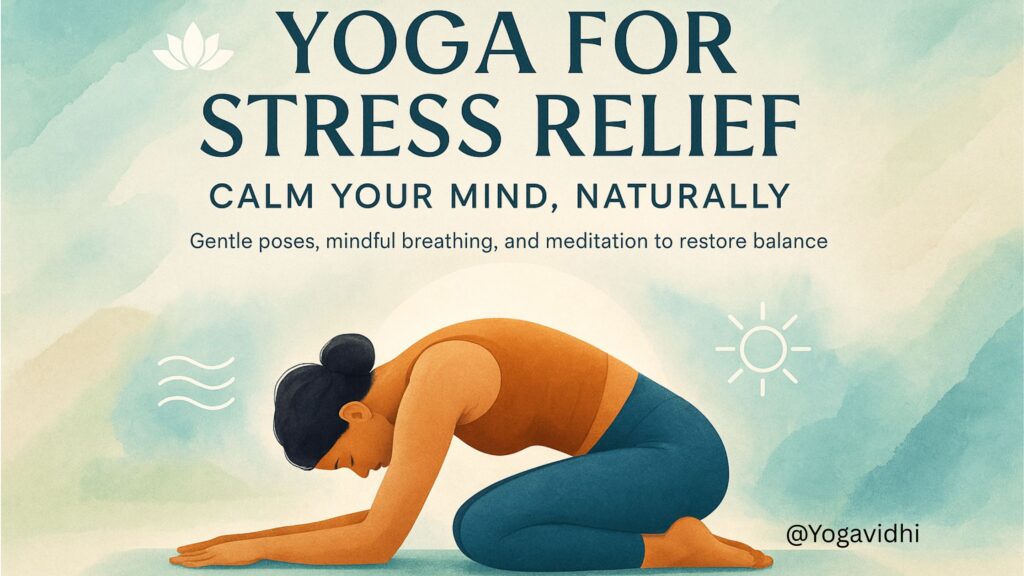In today’s fast-paced world, stress has become an unavoidable part of daily life. Whether it’s work pressure, relationship challenges, financial burdens, or simply information overload, everyone experiences stress in some form. But what if there was a way to calm your mind, soothe your body, and regain a sense of balance—all without medication? Enter yoga for stress—a time-tested, holistic practice that helps you unlock peace from within.
This guide will take you through everything you need to know about using yoga to manage stress naturally and effectively. From gentle poses and breathing techniques to meditation practices and daily routines, you’ll learn how to bring more calm, clarity, and emotional resilience into your life.
Yoga includes a variety of poses and breathing techniques that help relieve stress and encourage relaxation. Calming poses such as Child’s Pose (Balasana), Corpse Pose (Savasana), and Legs-up-the-Wall Pose (Viparita Karani) are especially effective. Furthermore, mindful movements and breathing practices—like the gentle flow between Cat and Cow poses (Marjaryasana to Bitilasana)—can soothe the nervous system and ease stress.
Table of Contents
What is Stress and Why Does it Matter?
Before we dive into yoga solutions, let’s understand the enemy: stress. Stress is your body’s natural response to any challenge or demand. While short-term (acute) stress can be helpful in urgent situations, chronic stress can wreak havoc on your physical, emotional, and mental health.
Common symptoms of stress include:
- Headaches and muscle tension
- Insomnia or poor sleep
- Fatigue and irritability
- Digestive issues
- Anxiety and depression
Left unchecked, stress can lead to serious health conditions like high blood pressure, heart disease, and weakened immunity. That’s why finding an effective and sustainable solution is crucial—and that’s where yoga for stress relief comes in.
How Yoga Helps Relieve Stress
Yoga is not just about flexibility or fancy poses. It’s a science of self-awareness and inner balance. Practicing yoga for stress combines breathwork, mindful movement, and meditation to calm the nervous system and reset your body’s stress response.
Here’s how yoga works to reduce stress:
- Activates the parasympathetic nervous system, promoting rest and relaxation
- Reduces cortisol (the stress hormone) levels naturally
- Improves mood by boosting serotonin and dopamine
- Enhances body awareness, helping you identify where you hold tension
- Encourages mindful breathing, grounding you in the present moment
Multiple studies show that regular yoga practice can significantly reduce symptoms of anxiety and depression. It’s a powerful tool to manage both acute and chronic stress.
Best Yoga Poses for Stress Relief
Gentle, restorative poses are best when practicing yoga for stress relief. These positions calm the body, lengthen the breath, and ease the mind.
1. Child’s Pose (Balasana)
A grounding posture that helps relieve tension in the back and shoulders.
How it helps: Calms the brain and promotes emotional relief.
2. Legs-Up-the-Wall Pose (Viparita Karani)
This passive inversion allows blood to return to the heart and calms the nervous system.
How it helps: Reduces fatigue, anxiety, and insomnia.
3. Cat-Cow Stretch (Marjaryasana-Bitilasana)
A gentle flow that synchronizes breath and movement.
How it helps: Releases spinal tension and enhances breath awareness.
4. Bridge Pose (Setu Bandhasana)
A gentle backbend that opens the heart and chest.
How it helps: Stimulates the thyroid and reduces mild depression.
5. Corpse Pose (Savasana)
The final resting pose in every yoga class.
How it helps: Triggers the relaxation response, allowing deep mental and physical release.
Practice each pose with mindful breathing for 1–3 minutes. You’ll feel the difference in just one session.
Breathing Techniques to Calm the Mind
Breathwork (pranayama) is one of the most effective parts of yoga for stress. When you’re stressed, your breath becomes shallow and fast. Conscious breathing reverses that pattern, signaling safety to your body.
Top Stress-Relieving Breathing Techniques:
1. Alternate Nostril Breathing (Nadi Shodhana)
Balances both hemispheres of the brain and clears energy channels.
2. Humming Bee Breath (Bhramari)
Creates soothing vibrations that relax the mind and nervous system.
3. Deep Belly Breathing
Involves slow, full inhalations and exhalations from the diaphragm.
Tip: Try 5 minutes of deep breathing each morning or before sleep for immediate calm.
Read More: 7 Chakras in Human Body: Unlocking the Energy Within
Read More: Yoga Therapy: A Holistic Path to Healing and Well-Being
| Yoga Pose / Practice | Primary Benefits | Best Time to Practice |
| Child’s Pose (Balasana) | Relieves tension in back/shoulders, calms the mind | Anytime you feel overwhelmed |
| Legs-Up-the-Wall (Viparita Karani) | Reduces fatigue, improves blood flow, helps with insomnia | Evening or before bedtime |
| Cat-Cow Stretch | Eases spinal stiffness, improves breath awareness | Morning or mid-day stretch |
| Bridge Pose (Setu Bandhasana) | Opens chest, stimulates thyroid, reduces mild depression | Morning or early evening |
| Corpse Pose (Savasana) | Deep relaxation, lowers heart rate and blood pressure | End of yoga session or bedtime |
| Alternate Nostril Breathing | Balances nervous system, enhances focus and clarity | Morning, before meetings, or bedtime |
| Humming Bee Breath (Bhramari) | Soothes the nervous system, quiets the mind | Evening or during high anxiety |
| Yoga Nidra (Guided Meditation) | Reduces stress, improves sleep, promotes deep mental rest | Bedtime or after work |
| Body Scan Meditation | Releases stored physical tension, improves body awareness | Evening or during breaks |
| Surya Namaskar (Sun Salutation) | Energizes the body, enhances blood circulation | Morning or early afternoon |
Meditation and Mindfulness in Yoga
Meditation is the heart of yoga—and a powerful antidote to stress. It teaches you to observe your thoughts without getting caught up in them.
Try These Meditation Techniques for Stress:
- Body scan meditation: Focus on relaxing each part of the body.
- Mantra meditation: Repeat calming phrases like “I am safe” or “Let go.”
- Yoga Nidra (Yogic Sleep): A guided relaxation that takes you to a state between wakefulness and sleep.
Yoga Nidra is especially useful for those dealing with anxiety, trauma, or burnout.
Creating a Stress-Relief Yoga Routine
The beauty of yoga for stress is that it doesn’t require hours of commitment. Just 15–30 minutes a day can transform your state of mind.
Daily Routine Example:
- Morning (10–15 min): Sun Salutations + deep breathing
- Afternoon (5 min): Seated Cat-Cow stretch + alternate nostril breathing
- Evening (15–20 min): Restorative poses + Savasana + Yoga Nidra
Set up a peaceful corner in your home. Use candles, calming music, or essential oils to enhance your experience.
Pro Tip: Consistency is more important than duration. Even short daily practice rewires your nervous system for peace.
Holistic Tips to Support Stress Management
Yoga works best when combined with a lifestyle that supports well-being. Here are simple additions to amplify your stress relief journey:
- Eat whole, nourishing foods (avoid caffeine and sugar spikes)
- Stay hydrated and avoid alcohol when stressed
- Get 7–9 hours of sleep—it’s non-negotiable
- Reduce screen time, especially before bed
- Practice gratitude journaling to reframe your mindset
All of these practices help you move from survival mode to thriving mode.
What the Experts Say
“Yoga therapy is a research-backed approach that helps regulate the nervous system and improve emotional resilience. It’s incredibly effective for managing chronic stress, anxiety, and even PTSD.”
— Dr. Anjali Mehta, Yoga Therapist & Psychologist
“Even a few minutes of yoga each day can shift how you feel. I’ve seen patients sleep better, worry less, and enjoy life more through simple yoga routines.”
— Ramesh K., Holistic Health Coach
These testimonials echo what countless yoga practitioners have discovered—yoga for stress is not just a practice. It’s a way of life.

Final Thoughts: Embrace Calm with Yoga
You don’t need to escape to a retreat or take drastic steps to manage stress. Everything you need is already within you. With each pose, breath, and moment of stillness, you reclaim your calm. You rediscover your center. You heal.
So unroll your mat. Close your eyes. Breathe in peace. Exhale the chaos.
And let yoga for stress guide you back home to yourself.
Frequently Asked Questions (FAQ):
Q. How often should I practice yoga for stress relief?
Ans: Even 10–20 minutes daily can bring noticeable benefits. Consistency is key.
Q. Can beginners try yoga for stress?
Ans: Absolutely! Start with simple poses and breathing techniques. You don’t need to be flexible to begin.
Q. Is yoga effective for anxiety and depression?
Ans: Yes. Many studies show yoga reduces symptoms of both when practiced regularly.
Q. Do I need any equipment to start?
Ans: A yoga mat is helpful, but you can start with a towel and comfortable clothing.
Q. When is the best time to practice yoga for stress?
Ans: Morning for energy and clarity, evening for unwinding. Choose what fits your schedule.
Q. What is stress in yoga?
Ans: In yogic philosophy, stress is understood through the teachings of Sage Patanjali. He describes an ideal state called swarupa—a condition beyond all physical tension and mental stress. However, the disturbances or fluctuations of the mind (chitta vrittis) pull us away from this blissful state of Ananda, creating imbalance in a yogi’s life. This disruption is what a yogi identifies as stress.
Declaration Note:
We use third-party videos and images on https://yogavidhi.com/ for educational and illustrative purposes. All rights belong to their respective owners. No copyright infringement is intended.



